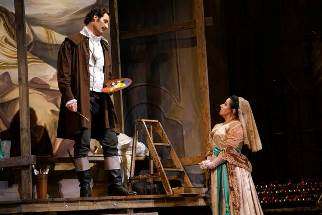|
Back
City Opera Lives Again! New York
New York City Opera (NYCORenaissance)
01/20/2016 - & January 21, 22, 23, 24, 2016
Giacomo Puccini: Tosca
Kristin Sampson (Tosca), James Valenti (Cavaradossi), Michael Chioldi (Scarpia), Christopher Job (Angelotti), Donald Hartman (Sacristan), Blagoj Nacoski (Spoletta), Darren K. Stokes (Sciarrone), Kevin Thompson (Jailer)
New York City Opera Orchestra, Pacien Mazzagatti (conductor)
Brooklyn Youth Chorus, Dianne Berkun Menaker (artistic director), Musica Sacra, Kent Tritle (conductor)
Lev Pugliese (production), Adolf Hohenstein (sets and costumes), Susan Roth (lights)

J. Valenti, K. Sampson (© Sarah Shatz)
After a disastrous bankruptcy and prolonged court battle over the late company’s remaining assets, New York City Opera – a cultural institution that had endured from the 1940s until just a few years ago – has returned to the scene. Having left its longtime home at Lincoln Center’s New York State Theater (now the David H. Koch Theater), City Opera spent what many assumed to be its death throes in other venues around New York. Now it seems to have a new home – and a long-term strategic plan – to offer seasons at the Rose Theater originally built to house Jazz at Lincoln Center. Substantial adjustment can clear the way for an orchestra pit and a credible theatrical stage on which 1,100 spectators can view what we should all hope will be new and invigorating programs. Just over one-fourth the size of the Met, the greater intimacy will surely allow for thoughtful productions of more intimate repertoire than the larger house can manage.
It was, then, a bit offbeat for the company to return with that old warhorse of melodrama, Puccini’s Tosca. But judging by the sell-out crowd at the opening performance, the choice was at least commercially judicious. Additional interest blossomed from Lev Pugliese’s production, which reproduced the sets and costumes from the opera’s original world premiere, in 1900, by the Russian-born German artist Adolf Hohenstein (credited in the program). After years of disappointment following the Met’s junking of its own highly realistic and dearly beloved Franco Zeffirelli production of Tosca in favor of the late Luc Bondy’s spare, vulgarized, and widely despised new take, the visual elements were easier on New York eyes. The only unfortunate moment came in the second act, when Scarpia closed the doors of his Palazzo Farnese apartment a bit too forcefully, causing the canvas backdrop to wobble too comically to preserve the scene’s gravitas. But that aside, the sets and costumes were for the most part attractive and occasionally even beauties to behold.
The opening night cast did not draw on the opera world’s greatest strengths. In the title role Kristin Sampson could hold her own, but not without some torturous ascents and wavering pitch problems. City Opera’s stalwart tenor James Valenti certainly delivered an impassioned Cavaradossi, but his verve could not make up for a voice that sounded rather too baritonal in its stridency. As the lecherous Scarpia, baritone Michael Chioldi fared noticeably as the best of the three leads, with a strong stentorian voice that captured the part’s vigorous evil. Kneeing Cavaradossi in the groin at the height of their second act confrontation may have been a bit gratuitous, but the point was clear. Under Pacien Mazzagatti’s baton the reconstituted City Opera orchestra played a reasonable rendition of the score, though at times there were rough edges and the occasional crack. On the whole, the experience was, well, like being at City Opera. And this is a good thing.
Paul du Quenoy
|